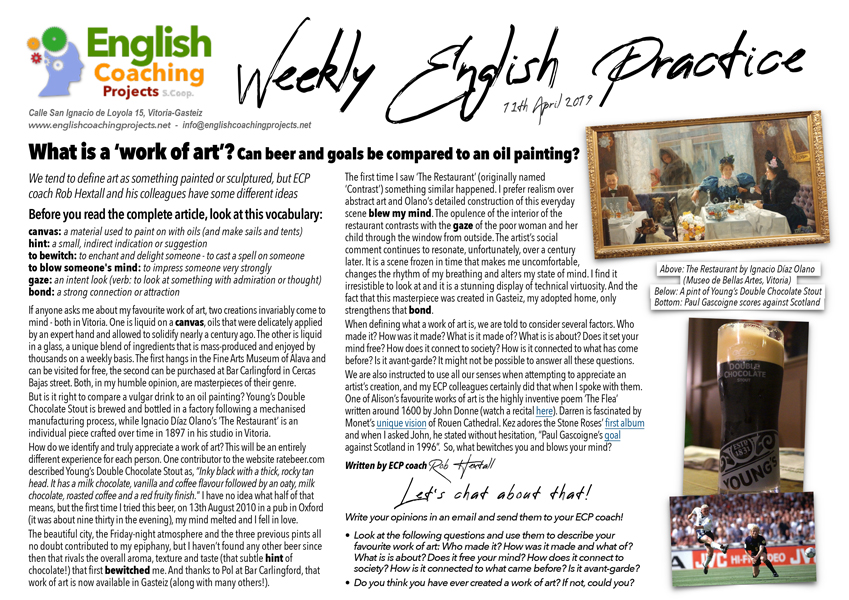ECP coach Rob Hextall wonders about the meaning of art, and asks his ECP colleagues their opinions. Their answers might surprise you! Find out more in this week’s Weekly English Practice!
Click on the image to download the pdf
We tend to define art as something painted or sculptured, but ECP coach Rob Hextall and his colleagues have some different ideas
Before you read the complete article, look at this vocabulary:
canvas: a material used to paint on with oils (and make sails and tents)
hint: a small, indirect indication or suggestion
to bewitch: to enchant and delight someone – to cast a spell on someone
to blow someone’s mind: to impress someone very strongly
gaze: an intent look (verb: to look at something with admiration or thought)
bond: a strong connection or attraction
Listen to the audio (refresh the page if it’s not visible)
If anyone asks me about my favourite work of art, two creations invariably come to mind – both in Vitoria. One is liquid on a canvas, oils that were delicately applied by an expert hand and allowed to solidify nearly a century ago. The other is liquid in a glass, a unique blend of ingredients that is mass-produced and enjoyed by thousands on a weekly basis. The first hangs in the Fine Arts Museum of Alava and can be visited for free, the second can be purchased at Bar Carlingford in Cercas Bajas street. Both, in my humble opinion, are masterpieces of their genre.
But is it right to compare a vulgar drink to an oil painting? Young’s Double Chocolate Stout is brewed and bottled in a factory following a mechanised manufacturing process, while Ignacio Díaz Olano’s ‘The Restaurant’ is an individual piece crafted over time in 1897 in his studio in Vitoria.
How do we identify and truly appreciate a work of art? This will be an entirely different experience for each person. One contributor to the website ratebeer.com described Young’s Double Chocolate Stout as, “Inky black with a thick, rocky tan head. It has a milk chocolate, vanilla and coffee flavour followed by an oaty, milk chocolate, roasted coffee and a red fruity finish.” I have no idea what half of that means, but the first time I tried this beer, on 13th August 2010 in a pub in Oxford (it was about nine thirty in the evening), my mind melted and I fell in love.
The beautiful city, the Friday-night atmosphere and the three previous pints all no doubt contributed to my epiphany, but I haven’t found any other beer since then that rivals the overall aroma, texture and taste (that subtle hint of chocolate!) that first bewitched me. And thanks to Pol at Bar Carlingford, that work of art is now available in Gasteiz (along with many others!).
The first time I saw ‘The Restaurant’ (originally named ‘Contrast’) something similar happened. I prefer realism over abstract art and Olano’s detailed construction of this everyday scene blew my mind. The opulence of the interior of the restaurant contrasts with the gaze of the poor woman and her child through the window from outside. The artist’s social comment continues to resonate, unfortunately, over a century later. It is a scene frozen in time that makes me uncomfortable, changes the rhythm of my breathing and alters my state of mind. I find it irresistible to look at and it is a stunning display of technical virtuosity. And the fact that this masterpiece was created in Gasteiz, my adopted home, only strengthens that bond.
When defining what a work of art is, we are told to consider several factors. Who made it? How was it made? What is it made of? What is is about? Does it set your mind free? How does it connect to society? How is it connected to what has come before? Is it avant-garde? It might not be possible to answer all these questions.
We are also instructed to use all our senses when attempting to appreciate an artist’s creation, and my ECP colleagues certainly did that when I spoke with them. One of Alison’s favourite works of art is the highly inventive poem ‘The Flea’ written around 1600 by John Donne (watch a recital here). Darren is fascinated by Monet’s unique vision of Rouen Cathedral. Kez adores the Stone Roses’ first album and when I asked John, he stated without hesitation, “Paul Gascoigne’s goal against Scotland in 1996”. So, what bewitches you and blows your mind?
Written by ECP coach Rob Hextall
Let’s chat about that!
Write your opinions in an email and send them to your ECP coach!
- Look at the following questions and use them to describe your favourite work of art: Who made it? How was it made and what of? What is is about? Does it free your mind? How does it connect to society? How is it connected to what came before? Is it avant-garde?
- Do you think you have ever created a work of art? If not, could you?


